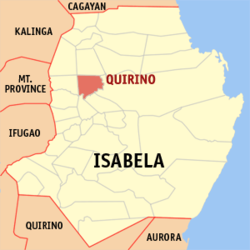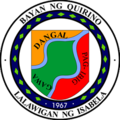Quirino, Isabela
Municipality in Isabela, Philippines! From Wikipedia, the free encyclopedia
Quirino, officially the Municipality of Quirino (Ilocano: Ili ti Quirino; Tagalog: Bayan ng Quirino), is a municipality in the province of Isabela, Philippines. According to the 2020 census, it has a population of 25,023 people.[4] Quirino was named in honor of President Elpidio Quirino.
Quirino | |
|---|---|
| Municipality of Quirino | |
| Motto(s): Abante! Quirino! Tuloy-tuloy ti progreso (Abante! Quirino! Continue to make progress) | |
 Map of Isabela with Quirino highlighted | |
Location within the Philippines | |
| Coordinates: 17°08′08″N 121°44′06″E | |
| Country | Philippines |
| Region | Cagayan Valley |
| Province | Isabela |
| District | 5th district |
| Founded | June 17, 1967[1] |
| Named after | Elpidio Quirino |
| Barangays | 21 (see Barangays) |
| Government | |
| • Type | Sangguniang Bayan |
| • Mayor | Edward D. Juan |
| • Vice Mayor | Victor Emmanuel G. Callangan |
| • Representative | Faustino Michael Carlos T. Dy III |
| • Electorate | 16,742 voters (2025) |
| Area | |
• Total | 126.20 km2 (48.73 sq mi) |
| Elevation | 50 m (160 ft) |
| Lowest elevation | 12 m (39 ft) |
| Population (2020 census)[4] | |
• Total | 25,023 |
| • Density | 200/km2 (510/sq mi) |
| • Households | 6,632 |
| Economy | |
| • Income class | 4th municipal income class |
| • Poverty incidence | 12.97 |
| • Revenue | ₱ 586.4 million (2022) |
| • Assets | ₱ 1,891 million (2022) |
| • Expenditure | ₱ 178.5 million (2022) |
| • Liabilities | ₱ 209 million (2022) |
| Service provider | |
| • Electricity | Isabela 2 Electric Cooperative (ISELCO 2) |
| Time zone | UTC+8 (PST) |
| ZIP code | 3321 |
| PSGC | |
| IDD : area code | +63 (0)78 |
| Native languages | Ibanag Ilocano Tagalog |
| Website | www |
History
Quirino was established by virtue of Republic Act No. 4901 dated June 17, 1967. It is located in the Mallig Plains in Western Isabela and has a total land area of 126.20 square kilometers. Agriculture is the primary industry for the local inhabitants.[6]
Geography
Summarize
Perspective
Quirino is a primarily agricultural town situated in the Mallig Plains region. The town is known for its sprawling flat lands used for growing crops such as palay or rice, peanut, corn, tobacco, and vegetables.[7]
It is bounded to the north by Delfin Albano, Mallig to the northwest, Roxas to the southwest, Burgos and Gamu to the south and Ilagan City to the east.
Quirino is 19.65 kilometres (12.21 mi) east of Ilagan (provincial capital), and 428.18 kilometres (266.06 mi) north of capital Manila.
Barangays
Quirino is politically subdivided into 21 barangays. [8] Each barangay consists of puroks while some have sitios.
- Binarzang
- Cabaruan
- Camaal
- Dolores
- Luna (Poblacion)
- Manaoag
- Rizal
- San Isidro
- San Jose
- San Juan
- San Mateo
- San Vicente
- Santa Catalina
- Santa Lucia
- Santiago (Villa Cacho)
- Santo Domingo
- Sinait
- Suerte
- Villa Bulusan
- Villa Miguel (Tabok)
- Vintar
Climate
| Climate data for Quirino, Isabela | |||||||||||||
|---|---|---|---|---|---|---|---|---|---|---|---|---|---|
| Month | Jan | Feb | Mar | Apr | May | Jun | Jul | Aug | Sep | Oct | Nov | Dec | Year |
| Mean daily maximum °C (°F) | 29 (84) |
30 (86) |
32 (90) |
35 (95) |
35 (95) |
35 (95) |
34 (93) |
33 (91) |
32 (90) |
31 (88) |
30 (86) |
28 (82) |
32 (90) |
| Mean daily minimum °C (°F) | 19 (66) |
20 (68) |
21 (70) |
23 (73) |
23 (73) |
24 (75) |
23 (73) |
23 (73) |
23 (73) |
22 (72) |
21 (70) |
20 (68) |
22 (71) |
| Average precipitation mm (inches) | 31.2 (1.23) |
23 (0.9) |
27.7 (1.09) |
28.1 (1.11) |
113.5 (4.47) |
141.4 (5.57) |
176.4 (6.94) |
236.6 (9.31) |
224.9 (8.85) |
247.7 (9.75) |
222.9 (8.78) |
178 (7.0) |
1,651.4 (65) |
| Average rainy days | 10 | 6 | 5 | 5 | 13 | 12 | 15 | 15 | 15 | 17 | 16 | 15 | 144 |
| Source: World Weather Online[9] | |||||||||||||
Demographics
| Year | Pop. | ±% p.a. |
|---|---|---|
| 1970 | 10,415 | — |
| 1975 | 12,571 | +3.85% |
| 1980 | 14,372 | +2.71% |
| 1990 | 17,070 | +1.74% |
| 1995 | 18,320 | +1.33% |
| 2000 | 19,986 | +1.88% |
| 2007 | 21,192 | +0.81% |
| 2010 | 22,285 | +1.85% |
| 2015 | 24,501 | +1.82% |
| 2020 | 25,023 | +0.42% |
| Source: Philippine Statistics Authority[10][11][12][13] | ||
In the 2020 census, the population of Quirino, Isabela, was 25,023 people,[4] with a density of 200 inhabitants per square kilometre or 520 inhabitants per square mile.
Economy
Summarize
Perspective
As of December 31, 2024, there are 21 barangays in the municipality. In terms of economic classification, all barangays are considered rural.[14]
Poverty incidence of Quirino
10
20
30
40
50
2000
39.46 2003
45.65 2006
24.80 2009
20.43 2012
15.89 2015
10.81 2018
15.59 2021
12.97 Source: Philippine Statistics Authority[15][16][17][18][19][20][21][22] |
Cabaruan Solar-Powered Pump Irrigation Project
On June 10, 2024, President Ferdinand Marcos Jr. inaugurated the largest solar-powered pump irrigation project (SPIP) in the Philippines located in Barangay Cabaruan. The event was attended by National Irrigation Administration (NIA) Administrator Eduardo G. Guillen, Speaker Martin Romualdez, Representative Tonypet Albano, Governor Rodolfo Albano III, and Quirino Mayor Edward D. Juan.[23]
The project, implemented by the National Irrigation Administration (NIA) with a budget of ₱65.77 million, aims to provide free irrigation to 350 hectares of rice fields, benefitting approximately 237 farmers in Isabela, often referred to as the Rice Granary of the North.
The system operates under the Magat River Integrated Irrigation System (NIA MARIIS) in Ramon, Isabela. It utilizes 1,056 solar panels to power two submersible pumps, capable of discharging 12,800 gallons of water per minute.[24]
Government
Summarize
Perspective
Local government
As a municipality in the province of Isabela, government officials at the provincial and municipal levels are voted by the town. The provincial government has political jurisdiction over most local transactions of the municipal government.
The municipality of Quirino is governed by a mayor being designated as its local chief executive, and by a municipal council as its legislative body in accordance with the Local Government Code. The mayor, vice mayor, and the municipal councilors are elected directly in elections held every three years.
Currently, there are 21 barangays which are also headed by elected officials: Barangay Captain, as the chief executive, and Barangay Council, whose members are called Barangay Councilors act as legislators. These barangays also have SK federation which represents the barangay, headed by SK chairperson and whose members are called SK councilors. All officials are also elected every three years.
Elected officials
| Position | Name |
|---|---|
| District Representative | Faustino Michael Carlos T. Dy III |
| Municipal Mayor | Edward D. Juan |
| Municipal Vice-Mayor | Victor Emmanuel G. Callangan |
| Municipal Councilors | Adela B. Corpuz |
| Jayson Anthony G. Callangan | |
| Earl N. Diampoc | |
| Rosalino P. Buguina | |
| Emelito S. Espiritu | |
| Willy R. Lucas | |
| Ricarte D. Ginez | |
| Mercelita M. Aquino | |
Congress representation
Quirino, belonging to the fifth legislative district of the province of Isabela, currently represented by Hon. Faustino Michael Carlos T. Dy III.[26]
Education
The Schools Division of Isabela governs the town's public education system.[27] The division office is a field office of the DepEd in Cagayan Valley region.[28] The Quirino Schools District office governs the public elementary and high schools throughout the municipality with the following schools.[29]
Elementary schools
- Binarzang Elementary School
- Cabaruan Elementary School
- Camaal Elementary School
- Luna Suerte Elementary School
- Manaoag Elementary School
- Quirino Central School
- Rizal Elementary School
- San Jose Elementary School
- San Juan Elementary School
- San Mateo Elementary School
- San Vicente Elementary School
- Santiago Elementary School
- Sinait Elementary School
- Sta. Catalina Elementary School
- Suerte Elementary School
- Villa Miguel Elementary School
- Vintar Elementary School
High schools
- Quirino National High School
- Rizal Comprehensive National High School
- Sto. Domingo Integrated School
References
External links
Wikiwand - on
Seamless Wikipedia browsing. On steroids.




